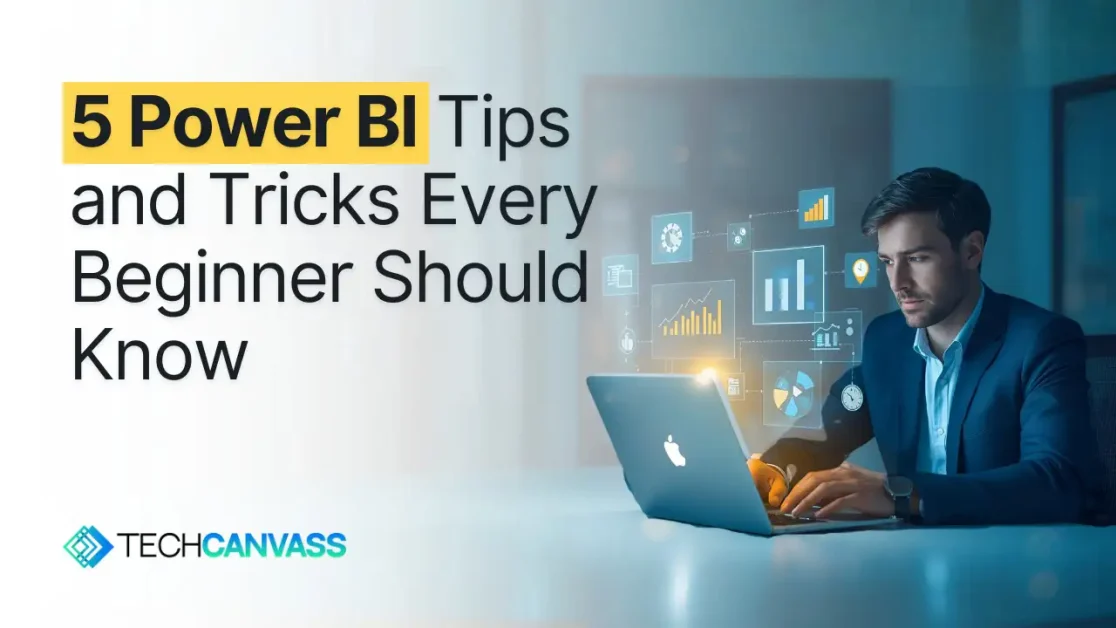Last Updated on October 6, 2025 by Techcanvass Academy
Table of Contents
Overview
When you first open Power BI, it feels like magic. A few clicks, some data loaded, and suddenly there’s a beautiful chart ready to impress. But that honeymoon phase doesn’t last long. Soon, you realize the real challenge isn’t building visuals—it’s managing messy tables, fixing broken relationships, handling refresh errors, or creating reports your team actually uses.
A few clever Power BI tips and tricks can help you avoid most of these issues. Forget the shiny visuals for a moment and focus on the fundamentals that make your reports accurate, efficient, and reliable. Here are five essential Power BI tips and tricks every beginner should know—the ones I wish someone had told me when I started.
“Forget the shiny visuals — mastering Power BI starts with smart habits that make your reports accurate, efficient, and reliable.”
Useful Links
- Explore our detailed Power BI Course to master dashboards, data modeling, and visualization from industry experts.
- Read our Introduction to Power BI article to understand what Power BI is and how it helps transform raw data into insights.
- Check our Power BI Certification Guide to learn about certification paths and exam preparation tips.
- Don’t miss our guide on How to Optimise Power BI Reports for faster performance and smoother user experience.
1. Data Modeling Best Practices
Data modeling is the skeleton of your report. If it’s weak, the whole thing falls apart no matter how good your charts look.
A couple of things make life easier:
- Stick with a star schema: Keep fact tables in the center—sales, orders, invoices—and connect clean dimension tables like products, customers, or dates.
- Keep relationships simple: Use one-to-many relationships and avoid bi-directional filters unless absolutely needed.
- Build your own Date table: Don’t rely on the auto-date hierarchy; a proper calendar table improves time intelligence and performance.
- Use measures instead of calculated columns: Measures calculate on the fly, saving memory and keeping your file lean.
2. Data Transformation Best Practices
Power Query represents the chaotic process that occurs before the food is served at the table. If you serve raw ingredients, nobody’s going to enjoy the meal.
Here’s how to keep it clean:
- Do cleanup in Power Query: Remove duplicates, fix data types, and trim spaces — basic housekeeping that saves headaches later.
- Always check data types: If Power BI treats a date as text, you’ll get stuck when building time-based visuals.
- Watch your steps: Each transformation adds work at refresh. Combine or remove unnecessary steps to improve performance.
- Reference instead of repeat: When two tables need the same treatment, reference one to keep your workflow tidy and easy to update.
- Name everything clearly: Avoid generic names like “Column1” or “Table (2).” Descriptive names make debugging and maintenance much easier.
3. Visualization Best Practices
Visuals serve as the shop window for your report. If they’re cluttered or inconsistent, people won’t trust the numbers, even if they’re right.
A few habits help:
- Keep each page focused on one story: If your dashboard is about sales performance, don’t cram in HR metrics just because there’s space.
- Stick to simple chart types: Use bar, line, card, or table visuals. Reserve complex or custom visuals for when they genuinely add clarity.
- Use colors with intention: Stick to a consistent theme aligned with your brand. A rainbow palette confuses users and distracts from insights.
- Prioritize layout: Place key visuals where eyes naturally go—top left of the page. Supporting charts can be positioned further down.
- Limit slicers: Use only those that help users filter insights effectively. Too many slicers clutter the page and confuse readers.
4. Report Refresh Best Practices
One of the biggest rookie mistakes is hitting refresh and watching Power BI crawl for half an hour. Refresh issues usually trace back to poor planning.
Better habits look like this:
- Only load what you actually need: If nobody cares about sales from 2011, skip them. Limit data to what’s relevant for your reports.
- Use incremental refresh for large datasets: Refresh only new or changed rows instead of rebuilding the entire dataset every time.
- Set realistic refresh schedules: If data updates once a day, don’t refresh hourly—it wastes system resources.
- Filter data at the source: Apply filters before loading into Power BI. Smaller queries run faster and reduce refresh time.
- Monitor refresh history regularly: Check refresh logs in Power BI Service. Catch issues early instead of waiting for user complaints.
5. Report Distribution Best Practices
Building the report is half the job. The other half—and often the more difficult one—is getting people to actually use it.
Here’s what helps:
- Publish to shared workspaces: Avoid “My Workspace.” Organize workspaces by team or department for better access management.
- Lock down permissions: Most users only need Viewer access. Limiting Editors prevents accidental data or design changes.
- Package reports into Apps: Share reports through Apps instead of random links. It’s cleaner and easier to navigate.
- Encourage subscriptions and alerts: Teach users to set up notifications so data comes to them automatically.
- Test on mobile: Many executives check dashboards on phones first. Ensure visuals adapt well to smaller screens.
Conclusion
Power BI isn’t just about making cool graphics. The most important thing is to make reports that are correct, easy to read, and really help people make decisions. Most of that success comes from good habits, like strong data models, clean transformations, purposeful visuals, efficient refresh setups, and sharing reports in a way that makes sense.
“The real power of Power BI lies not in flashy visuals, but in the habits that make your reports accurate, efficient, and trusted.”
If you use these Power BI tips and tricks, you won’t make the same mistakes that most beginners do, and you’ll be able to make dashboards that people trust and use. Power BI is just a tool. What really matters is how you design, improve, and deliver insights that make a difference.
Useful Links
- Explore our detailed Power BI Course to master dashboards, data modeling, and visualization from industry experts.
- Read our Introduction to Power BI article to understand what Power BI is and how it helps transform raw data into insights.
- Check our Power BI Certification Guide to learn about certification paths and exam preparation tips.
- Don’t miss our guide on How to Optimise Power BI Reports for faster performance and smoother user experience.
FAQs
Q. What are some essential Power BI tips and tricks for beginners?
Certain crucial Power BI tips and tricks are creating a simple data model, opting for measures rather than calculated columns, and simple visuals. Power Query transformations should also be learned by new users, along with scheduling refresh properly for enhanced performance.
Q. How can I apply Power BI best practices to improve my dashboards?
To follow Power BI best practices, begin with a uniform color theme, a single story per page of the report, and a sole usage of the visuals that deliver value. Steer clear of clutter, make labels clear, and sample dashboards on both desktoping and mobility devices for a perfect user experience.
Q. What is the ultimate Power BI beginner guide for effective learning?
A good Power BI primer should cover basics such as connecting to sources, shaping using Power Query, and creating a star schema. A good primer should also cover DAX formulas, interactivity on report visuals, and publishing reports to Power BI Service for consumption of findings.
Q. How can Power BI dashboard tips help me create professional reports?
Power BI dashboard recommendations make you create dashboards that are easy on the eye and effective dashboards. Keep relevant images at the upper-left corner, have serious filters on slicers, and maintain standardized formatting for your dashboards to look professional yet easy to read.
Q. What common mistakes should new users avoid in Power BI?
The new users tend to over-report reports with irrelevant data, omit relevant data cleaning, or make intensive visuals that mislead users. Adherence to Power BI best practices such as clean modeling of data, correct naming conventions, and effective queries avails a way out of such problems, guaranteeing efficient performance.
Q. Are Power BI tips for beginners different from advanced techniques?
Yes. Power BI tricks for beginners revolve around learning basics like Power Query, relationships, and measures. Advanced methods involve performance tuning, advanced DAX calculations, and adding AI visuals or Copilot for deeper business insight.
Q. Where can I learn Power BI from scratch and prepare for the PL-300 exam?
Learn Power BI from basics with the Power BI Course at Techcanvass. This course is PL-300, Microsoft certified exam, AI Copilot-enabled learning for hands-on experience on actual analytics, suitable for both beginners and experienced pros who wish to get Power BI certified.



